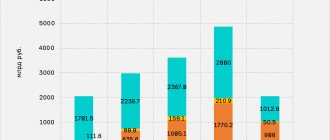Greetings dear readers! Today's article is devoted to an unusual topic - venture capital. I will demonstrate the possibilities and goals of attracting this type of financing. I’ll tell you about the funds that engage in this type of activity: what they look like from the inside and what their operating principles are.
I'll show you how they make decisions and what they need to do to get capital for their business project. I will briefly describe the direct investment markets in other countries and provide current figures for the Russian market.
What it is
Venture capital is direct funds used to finance new fast-growing companies or already established firms that find themselves in difficult financial situations that involve a high level of risk but expectations of multiple returns.
In simple terms, this is capital that is invested in the early stages of company formation or at the stage of financial instability of a business. It is often associated with the high-tech sector, but funds invested in the early stages of a tomato business can also be called venture capital.
To build an effective system for coordinating direct investments from investors, there are special funds.
Distribution of roles in a venture firm
Such organizations are headed by investment managers who, as a rule, have extensive experience in investments of this type. At the bottom rungs of the corporate structure are limited partners. These can be either some kind of institutions such as non-state pension funds, collective investment funds, etc., or private wealthy investors.
The main managers of the company receive a portion of the profits from all company projects. The remaining members of the organization are focused on specific areas of investment and receive profits only from those transactions in which they participate.
Fund structure
Basically, a venture fund is structured as a pool of funds raised from investors. Control and management is carried out by a management company owned by the main managers of the fund.
Next, the money collected from partners is invested in various projects, and portfolios of investments are collected. Most venture funds operate on a 10-year organizational life cycle model.
Investment objects
Venture capital can be distributed in a variety of ways. Objects can be companies from any industry, geography and business stage. Such investors can consider not only startups for their investments, but also companies that are on the verge of bankruptcy. Venture capital can be invested in even unregistered organizations. This phenomenon is called “seed investment”.
Funds are often universal in their investment strategies, but there are also highly specialized financial institutions.
Mobilizing venture capital
Some funds use a model of raising funds from partners as investment opportunities arise, others raise capital only during a certain period of time of forming a venture fund.
Fundraising tools may include special applications or the sale of shares.
In addition, “subscription” and “transitional” investments take place in many financial structures. Their meaning is that if the investment is implemented within six months, then the proceeds are automatically reinvested in new projects.
Salary
The leaders of a venture capital organization expect to receive annual commission payments ranging from 3 to 7% of the total capital of the venture fund and 1/5 of the profit generated by investment projects.
The remaining partners receive money only from the implementation of investment ideas.
What sources does it come from?
Sources of direct investment are divided by type of capital and ownership structure.
Regarding the monetary component, they can be:
- using borrowed capital;
- without the use of borrowed funds.
According to their ownership structure, they can be divided into:
- family or private sources of capital;
- institutional organizations.
Among the latter are public and non-public companies, banking institutions and holding structures.
Differences from a bank loan
A venture investor essentially buys a stake in a business, hoping to then sell it to another investor for a higher price. A loan is borrowed funds on which you must pay regular interest and a portion of the cost of the debt.
We can also say that venture capital is an equity method of directly raising funds, while credit involves debt financing.
Investment risk management
Depending on what type of risk an investor decides to mitigate, he needs to use different tools. The correct choice of these same instruments can significantly reduce investment risks and increase the profitability of the entire portfolio as a whole .
For example, the risks of investing in stocks are “removed” mainly through proper diversification. But risk management is not just about putting assets into different “baskets”; it is a large system, the main principles of which are:
- carry out proper diversification (i.e. reduce all types of investment risks - country, currency, industry);
- do not invest borrowed funds;
- choose assets for which potential profits always cover possible losses (expectation should be on your side);
- always limit losses;
- have a plan for exiting the investment;
- invest for a long time - with long-term investing, the risks are reduced (in proportion to the years passed).
It is important to understand that you should not excessively reduce investment risk by sacrificing profitability. We need to find some kind of balance.
For example, the risks of investing in bonds include the bankruptcy of the issuer, which can be eliminated by purchasing OFZs and municipal bonds, the default of which is very unlikely. But the return on such investments will be at a level slightly higher than inflation, and in the long term you may simply not receive enough profit. Adding shares to a portfolio and increasing the risk level by several percent can significantly increase the return on investment.
Kinds
Types of venture capital are divided depending on the stage of business development for which financing is allocated:
- Sowing. As a rule, there is not a very large amount of capital that is provided to a specific entrepreneur or team to create a project.
- Newly formed companies. Investments at the product development stage.
- First stage. The initial stage of releasing products and attracting customers.
- Second phase. Tools for initial scaling of an organization.
- Third stage. The stage of active expansion and growth of the customer base.
- Transition financing. Capital for companies that are planning to go public in the coming year.
- Reorganization. Financing of organizations with financial problems or in a pre-bankruptcy state.
- Buyout by managers / using a loan. Capital for the buyout of the business by the main partners.
- Privatization or M&A. Funds used in mergers, acquisitions, or the process of transitioning a business from public to private ownership.
US Treasury Bonds (Treasuries)
This is OFZ, only in American style. They are also extremely reliable - they now serve as a protective asset, just like gold once did. If the economy is in a fever, everyone buys treasuries (even the word fits - treasures means “precious” in English).
U.S. Treasury bonds are typically issued in 10-year installments. These are the most popular and traded IOUs in the world.
And here’s another interesting article: 15 habits that drag you into poverty: what you need to do to become richer
The yield on them is about 1-2% per annum. But this is in dollars. Considering how much the ruble is devaluing against the American dollar, it turns out that buying treasuries is very profitable.
It is not possible to buy US Treasury bonds directly from the Russians. But you can buy an ETF for them - namely the FinEx Cash Equivalents UCITS ETF. You can purchase ETFs on the Moscow Exchange.
Pros and cons of venture capital
The main positive point for an investor is the possible return on investment. It can be calculated in hundreds and thousand percent. It is logical to assume that the main disadvantage for a venture capitalist is the high risk of losing invested funds.
From the point of view of a company that attracts such financing, the main advantage I will highlight is the opportunity to receive funds for development without collateral, having only an idea and a business plan. Well, the downside, of course, is selling a share of ownership of your business.
Federal loan bonds
This is perhaps the most highly reliable asset. These are debt obligations of our country, or, to be more precise, of the Ministry of Finance. Profitability on them is ensured by the state, and the state has never let us down, and if a large polar animal comes to the state, then it will be bad for everyone. So while the Ministry of Finance is solvent, OFZs are also solvent and very reliable.
The yield on OFZ is about 7-8% per annum. If the Central Bank continues to raise the rate, the nominal value of bonds will creep down (and it is already low), and the yield will become higher.
How to get venture capital
The most important criterion for obtaining investment capital is a well-constructed business plan with non-trivial ideas and concrete steps to increase value.
However, statistics are such that of all proposals received by venture funds, less than 5% actually receive funding at least in part.
The importance of funding
Sometimes venture capital investments are the only way to attract long-term financing for a young enterprise or a mature company with certain economic problems.
In the 1970s, this market practically did not exist. And now this type of obtaining funds for business development plays a huge role in the economies of different countries. For example, in the United States, venture capital-backed companies account for well over a quarter of the country's GDP.
Application, project summary and business plan
To receive funding, you first need to send an application and a resume to the venture fund, which should include information about the industry, the company's plans, the level of management and the prospects of the enterprise.
Next, you should fill out and submit a business plan, where all the processes, possible benefits, costs and other data directly related to the activities of the project are described in great detail with a mathematical justification.
Amount of requested investment
When determining the amount of funds requested, you should be guided by standard criteria:
- The requested amount must be sufficient to finance the current stage of activity and move on to the next round of capital raising.
- The more money a company plans to raise, the larger share of the company's capital will have to be given away.
Maturity of the company submitting the request
When raising venture capital in the early stages of the cycle, about 40% of the company is usually sold. When subsequently attracting investments to scale their activities, the founders have to part with another 10–20% of their company.
Management personnel of the enterprise
The more qualified the management team in a company is, the more eminent it is, the easier it will be for it to receive venture capital.
Ultimate goals
The ultimate goal for a venture fund is often to sell its stake at an IPO or to an investment strategist. Therefore, an entrepreneur needs to clearly formulate what competitive advantages the company plans to gain in order to interest potential investors in the future.
ETF
This is an exchange-traded fund, where an entire index of stocks or bonds is collected under one package. ETFs come in a variety of indexes. There are not many of them in Russia - only 15 pieces and another one from Sberbank.
And here’s another interesting article: OFZ-n third issue: cost, commission and purchase features
ETFs are safe due to their wide diversification - under the hood they have dozens and even hundreds of issuers included in the indices of the USA, Germany, Great Britain, Russia and other countries. In short, these are shares and bonds of the most profitable and reliable companies.
On average, the yield of ETFs is 15-20% - but it all depends on the chosen index. Read more about ETFs and how to buy them on the Moscow Exchange in this article.
Geographical differences in venture capital
The largest and legally prepared market for this type of investment activity is the US market. But this trend is gradually shifting towards other states.
The world's largest venture funds:
- Accel Partners (USA);
- Softbank (Japan);
- Index Ventures (an international firm headquartered in London and San Francisco);
- Sequoia Capital (USA);
- Kleiner Perkins Caufield & Byers (USA);
- DCM (an international company with main offices in Silicon Valley, Tokyo and Beijing);
- Insight Venture Partners (USA, New York);
- Draper Fisher Jurveston (USA, California);
- Sofinnova Partners (USA, California);
- Matrix Partners (USA).
USA and Canada
According to reputable publications, in these countries venture investors make multi-billion dollar investments through private equity on an annual basis. Infrastructure, trade and legal relations between states lead to the fact that many funds operate in the markets of both countries at once.
The largest and most significant platform is the so-called Silicon Valley. It is located from San Francisco to San Jose. It is believed that the smartest people on the planet work there.
2/3 of the total volume of direct investments in business in these countries comes from pension funds, insurance companies and charitable organizations.
Europe and Russia
Europe is an established economy with a stable share of venture capital at around 10% of total investment.
Half of the total volume of direct investments here comes from banking structures. About 30% is provided by government, insurance, pension and charitable organizations. Accordingly, the share of private funds is at the level of 20% of the volume of funds.
In Russia, this type of business financing is developing at an exponential pace. Recently, sanctions and economic pressure from Western countries have been a factor limiting the flow of capital into venture funds.
Some current figures about the Russian direct financing market:
- There are 189 funds of this type operating in the Russian Federation.
- In 2021, 185 companies at the initial stage of development were financed, and 20 companies that previously received investments exited with a profit.
- The operating capital of venture capital organizations in Russia is almost $4.2 billion.
The public sector still plays a major role in the Russian market. More than 25% of funds operate with government participation.
The most active Russian companies providing direct financing in 2017–2018:
- Runa Capital (16 transactions);
- I2BF (15 transactions);
- Target Global (15 deals);
- Primer Capital (10 deals);
- Fort Ross Venture (9 deals);
- Gagarin Capital (9 transactions);
- QIWI Ventures (7 deals);
- Business Angels Fund “AddVenture” (7 transactions).
India
India is a fast-growing economy and the amount of venture capital in the country is increasing every year. Its share in total investment activity is also increasing.
China
Now there is information that in 2021 the direct investment market in China has already caught up with the American one in terms of volume. Investments are predominantly directed to companies from the country's technology sector.











